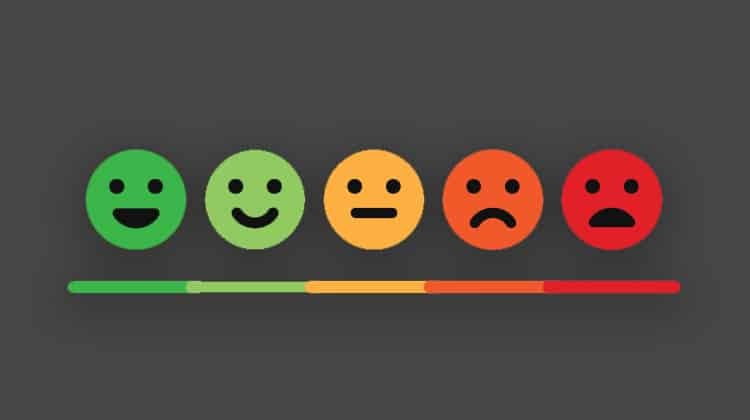Sentiment Analysis: What Is It and How It Can Help Your Business
by Cydney Hatch • July 16, 2019
Have you ever released a new product and everyone was talking about it on social media? There might have been hundreds of Instagram mentions, Facebook posts, Snapchat shout outs and tweets—but what did it all mean? For many people there are two options to gauge the traffic success:
- This is AWESOME, I am getting people to talk about my product and they love it
- This is BAD, a lot of people did not like my product and they are lighting me up on social media
Unfortunately, people’s feelings and their actions cannot solely be organized in two neat “buckets” of positive and negative. You need more context to truly understand how people feel about your brand and or business.
This is where Sentiment Analysis can come in!
Sentiment Analysis on social media helps you understand the true feelings of people about your brand. If you are new to this concept or want to look for a way to dive deeper into your social media analytics, this is the article for you! Let’s take a look at what Sentiment Analysis is and how you can use it to benefit your business!
What is Sentiment Analysis?
Sentiment Analysis is simply gauging the feelings behind a piece of content or the attitude towards a piece of content whether it’s an article, comment or opinion. At the most basic level, sentiment-analysis tools classify pieces of text as positive, negative or neutral. An easy example of this is found in modern-day politics with people tweeting phrases like:


As those tweets express very clear cut emotions, one being positive and the other is negative, we know as marketer’s customer emotions are never truly this clear cut. Generally, when we speak, we share a wide range of emotions in comments and sentences that need more context to fully understand.
So, if we were to use tweets talking about products and businesses, the customer responses might not be as clear cut to define. For example, Joanna Gaines‘s #MagnoliaHome got some of the following tweets:



These tweets are difficult to understand for a few different reasons. The first tweet lacks context on what they actually feel about the products, it just generally shows excitement to see the new line which isn’t something that is truly helpful to a marketer trying to gauge product line success. It’s not easy to make the decision about which feeling is there. The second is problematic because it just simply talks through emojis. The third, the positive affirmations is assumed that they like the salt and pepper pots and the photo is the thing that gives context.
Although these are more complex to identify, a Sentiment Analysis algorithm built on training data can classify the feelings in the above tweets. So, measuring social sentiment is an important part of any social media monitoring plan. It helps you understand what a person’s feelings are behind a piece of social content which can give you better insights into your content marketing strategy.
Knowing the emotion behind a post, review, etc can provide important context for how you proceed and respond. You can apply sentiment analysis to:
- Product reviews and responses
- Individuals
- Issues, topics, events
- Online and social media content
To learn more about why you need Sentiment Analysis and how you can best use it for your business, let’s hop into the next section!
How Does Sentiment Analysis Work?
From the dawn of time, people have always been interested in other people’s opinions. We use those opinions and feelings for our benefit.
As a business and or leader, it’s important to understand the complexities of your target audience. When we speak of computer-based Sentiment Analysis, data is at the core of everything. The data can include social media feeds, music, images, videos, email, microblogging, chat, etc…
How that data is collected is typically done in a few steps from collecting, analyzing and reporting meaningful information. Mind you, these can differ depending on the data application you decide to invest in. The general steps are as follows:
Collect Your Data
The first step in any Sentimental analysis is collecting the data from your audience. This almost always from user-generated content on social media networks, blogs, and forums.
When you grab content from those places online the data is complex as there are different ways to express feelings: emojis, slang, languages, contexts, etc. As a result, you’ll probably need to spend a good chunk of time cleaning and organizing the collected data by eliminating irrelevant content from the mix.
Subjective expressions including beliefs, opinions, and views are retained, and objective information including facts are discarded.
Data Organization and Assignment
After data is collected with your application, it is time to organize and assign your content data points! Sentiment assignments are made and based on approaches including:
- Machine learning: Predict the polarity of sentiments based on trained and test datasets
- Lexicon learning: Uses predefined lists of words that are already associated with specific sentiments
- Hybrid learning: Uses a combination of both machine learning and lexicon approaches to improve sentiment classification performance
By using any of those learnings, data points are typically organized by “feelings” or by the type of content it is like:
- Product reviews
- Sentences and Comments
- Opinion Discussions
- Etc…
After the information is sorted, organized and analyzed, the data will be displayed visually through a report.
BONUS: Sentiment Analysis Programs to Try
There are a variety of sentiment analysis tools on the market that are perfect for any level of skill and familiarity. Some of the best in my opinion are:
Most of these programs have a free trial, so be sure to try a few to see which best fit your business needs!
Why Do You Need Sentiment Analysis and How Do I Use It?
Sentiment Analysis insights are often “game-changers” for businesses and organizations alike. The ability to extract insights from social data is a practice that you need to have if you want to make the most of your digital and social marketing in today’s modern world.
In simple terms, Sentiment Analysis helps generally with:
- Identifying negative mentions a
- Spotting PR crises before they happen
- Spotting super happy users who can possibly become brand ambassadors
Below are some of the ways you can use Sentiment Analysis for your business:
Get Audience Insight and Improve Products
I think if we could read people’s minds it would be both delightful but also terrifying. We all want to know what people are truly thinking and Sentiment Analysis does that trick!
I mean, any market wants to soak up as much data about their audience as they possibly can. After all, understanding your audience’s reactions to your posts helps you plan strategically for future campaigns and content!
For example, if you were a business launching a campaign about your brand’s new glitter body scrub and your marketing team notices that people are really miffed about glitter and how the microplastic material hurts marine life, you will be able to get ahead of the curve and address the problem before launch. This might mean discontinuing the product, adjusting content messaging, making a new product or donating to an environmental organization.
By quickly understanding consumer attitudes towards your products and reacting accordingly, you will be able to not only improve the relationship with your audience—you’ll also be able to improve your general marketing. People like to be heard and monitoring sentiments can keep you from being a tone-deaf business! If you can improve from the feedback of the people who pay your bills, that is priceless! Do not squander it!
Research Your Competition and Improve Your Business
Of course, it makes sense to soak up how your business is doing online, but have you thought about also taking advantage of your competition as well?
Not only does this help you see how your business stacks up against other businesses, but it can also help you reverse engineer what they are doing well. For example, if you are a bike business that creates customized bikes and you see that your competition’s redesign of a seat has some serious problems that people are addressing online, you can see how your product can fill a void of problems their customers are having.
By following your competition, you can identify what tactics are working and see in detail where you excel and where you can improve as a business.
Build Good Rapport and Gain Loyal Customers
Monitoring social sentiment is critical for customer service! Hands down. When you are a public-facing business that relies on reviews, it’s important to be tuned in to what people are saying and what they expected from your products and services. What monitoring sentiment does is it gives you a unique opportunity to turn a bad customer experience into a positive one!
For example, if you are a coffeehouse in San Diego California and you got a negative sentiment review from a customer that is gaining a lot of attention you have the opportunity to publically show you are wanting to build a good rapport with those who invest in you. Offer them a coffee on you next time you are in and thank them for their time, thoughts and honest feedback.
By doing that, and paying attention to the feelings of your customers, you are building a good sense of understanding and trust. People love brands who seem in touch with their “people.” Brands that do not handle social media crises will usually pay a high price for it. On the flip side, brands that do handle these crises well, develop new loyal customers.
Sentiment Analysis: Ready to Go
Sentiment Analysis is a specific step beyond general social listening. Think of Sentiment Analysis as a subset of social listening which digs into the positive, negative and neutral emotions surrounding those mentions.
By doing that, you are able to learn more about who your customers are and how you can better engage with them. Consumers gravitate to companies that seem to know them, and using Sentiment Analysis is a great way to show you the way to your customer’s hearts!
If you have more questions about Sentiment Analysis or need suggestions on how to get started, let me know in the comments! There are a lot of fun things to do with this technology, so I am here to help you make the most of it!
What are your thoughts? Do you see the value in Sentiment Analysis? How do you apply those insights to improve your marketing? Share your thoughts in the comments below.




